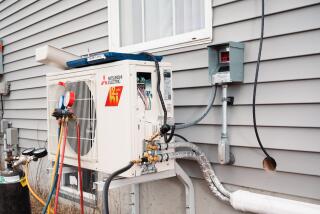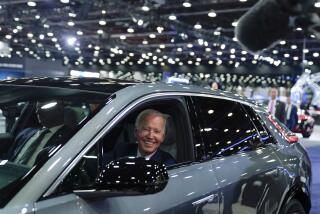The Key: Reduce Demand
- Share via
PALO ALTO — It’s hard to know exactly what the Bush administration intends the role of conservation to be in its energy policy. Just two weeks ago, Vice President Dick Cheney, who heads the president’s energy task force, insisted that “Conservation may be a sign of personal virtue, but it is not a sufficient basis for a sound, comprehensive energy policy.” President George W. Bush was much less hard-line when he introduced his energy plan to the nation last Thursday. Although he pledged that “conservation does not mean doing without,” he also stated that “Our new energy plan begins with a 21st century focus on conservation.”
Let’s hope he means it. Energy conservation and efficiency improvements are not only economically sound, they also have a huge potential to reduce the United States’ long-term energy needs. With the right policies and incentives, we can make major improvements.
To see how we have gotten to this point, it is useful to analyze our energy requirements as the product of two factors. The first is the size of the economy as measured by the inflation-adjusted gross national product (GNP). The second is a number called energy intensity, which is the amount of energy required to produce a dollar of gross national product. Multiply these two--how much we’re producing by how much energy it takes to produce a dollar’s worth of goods or services--and you get the total energy needs of our society.
From this perspective, it is easy to see why we are in an energy panic. In the 1990’s the economy grew at a rate well above its historic average. Energy intensity also improved, but slowly. As energy demand has shot up and we’ve moved closer to capacity, energy prices, as is normal in a market economy, have also shot up. Since California’s economy grew faster than the national economy, it’s no surprise that the biggest crunch is here--despite the fact that our per-person energy consumption is only two-thirds that of the national average.
If we believe the new-economy folks, who predict a 3% to 4% annual growth rate, the problem isn’t going away. The President seems to believe them: a projected growth rate of 3.5% is built into his energy plan. To understand what this means, we have to look at the other factor in the energy equation.
Between 1986 and 1999, energy intensity dropped by 1.3% per year. Two things drove this improvement: a shift in economic activity away from manufacturing into service industries, and improvements in conservation and efficiency. Government projections for the next 20 years assume that we can do a little bit better than we have for the last 15, predicting an improvement in energy intensity by 1.6% per year.
If you put together an economy growing by 3.5% per year as energy intensity declines by 1.6% per year, you get an increase in energy demand of about 2% per year. Projected over 20 years, this means the U.S. economy will need nearly 50% more energy. This is what lies behind statements that we must bring a new power plant on line every two weeks for the next 20 years, and that we will need to vastly increase our fossil energy supply.
To hold down demand for new energy, we have to work on the energy-intensity factor, which is where conservation and efficiency come in. The U.S. is currently the least energy efficient of the industrialized nations. We use twice as much energy per dollar of GNP as Japan, and about 1.5 times as much as Western Europe, which leaves considerable room for improvement. Improvements would also save money, thus benefiting the GNP part of the equation.
Opportunities for conservation and efficiency abound. Here are three examples. Modern natural gas-fired turbine-driven power plants have an efficiency for converting primary fuels into energy of 50% to 60%. Old-style coal-fired steam-driven power plants have an efficiency of 35% to 40%. Industry knows this and that is why almost all of the new power plants are gas-fired. They are cheaper to build, and pollution control is much less expensive than for the much dirtier coal-fired power plants. Relaxing pollution controls on coal would be a step in the wrong direction both environmentally and economically.
There are also huge opportunities in the transport sector. The administration’s new energy policy promises incentives for developing hybrid automobiles, which is a good thing. The typical automobile gets about 20-miles-per-gallon, while the first-generation gasoline-electric hybrids now coming out of Honda and Toyota get over 40-miles-per-gallon. With gasoline at $2 per gallon, and figuring that the average car is driven 12,000 miles per year, a car that gets 40 miles to the gallon would save its driver $3,000 in fuel costs over five years. If such a car could be bought for no more than $3,000 above the cost of today’s cars, we would have an economic winner as well as an energy winner.
Another easy fix is in our lighting. Compact fluorescent light bulbs use one-quarter the energy of standard incandescent bulbs with the same light output. They cost more to buy, but they last much longer, and, with electricity at ten cents per kilowatt hour, over the 8,000-hour lifetime of a compact 25-watt fluorescent, the consumer would save $60 over the cost of an ordinary 100-watt incandescent bulb, while reducing energy use by 75%. There are a lot of light bulbs in a standard house, which means a lot of potential savings .
These are just a few of many examples, but they give an idea of the possibilities. Perhaps we owe Cheney a debt of gratitude for his comment about conservation. The negative reaction it provoked undoubtedly moved Bush toward a greater emphasis on conservation and efficiency in his national energy policy. But the centerpiece of the administration’s program is still increased supply rather than reduced demand. There is no way to escape the need for some increase in supply in the short term, as the measures required to increase efficiency will take time to develop and to become accepted.
What we need from Washington are greater incentives along with regulations encouraging conservation and efficiency. Industries and citizens respond to incentives. But it will take increased public demand for Washington to act.
Americans respond well to challenges when they believe in the goal. I want to issue such a challenge. Let’s decrease energy intensity by 3% a year, rather than the 1.3% we’ve seen for the last 15 years. It will take time, but let’s try and do it in less than 10 years. An inspirational slogan would be useful, and I’m not an ad man. But here are a few possiblities: If you worry about global climate change, how about “Energy Efficiency to Save the Environment.” If you worry about your pension, how about “Energy Efficiency to Save Social Security.” If you are poor, how about “Energy Efficiency for a Higher Minimum Wage.” Increased energy efficiency can contribute to all of these and more.
More to Read
Get the L.A. Times Politics newsletter
Deeply reported insights into legislation, politics and policy from Sacramento, Washington and beyond. In your inbox twice per week.
You may occasionally receive promotional content from the Los Angeles Times.






